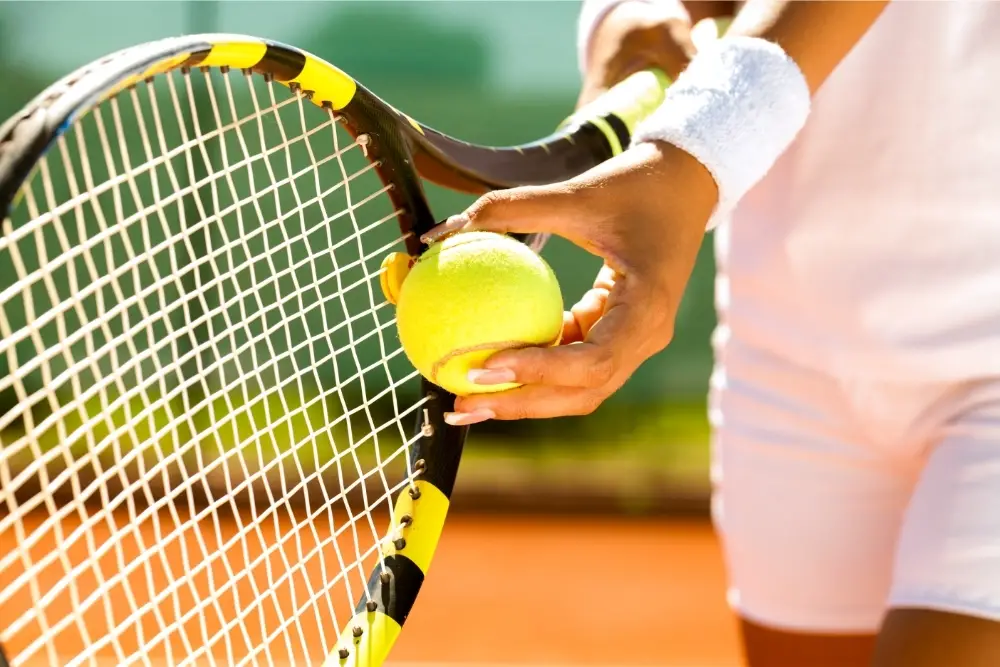Hey! This site is reader-supported and we earn commissions if you purchase products from retailers after clicking on a link from our site.
If you’ve ever seen a professional tennis match from start to finish, you’ve most likely witnessed the coin toss to determine who serves first. So you could be forgiven for believing this is a clear answer.
However, you may be surprised to learn that the person who wins the toss does not always serve first, but rather has a choice of three options.
In this article, we’ll take a look at the different methods to determine who serves first in tennis, and what they mean.

The Coin Toss
A coin toss can be used at the beginning of the match to establish which player serves first and which ends of the court they will begin the match on. Whoever wins the coin toss does not always serve first (although they do often choose this option). They are given one of the following options.
- Serve or receive first: The player who wins the toss has the option of serving first or receiving first. The idea behind receiving first is that the opponent may not be fully warmed up or could be apprehensive, thus it’s a good opportunity to break their serve in the first game.
- Which half the players start from: If the weather is unusually windy or sunny, instead of deciding who serves first, the players may prefer to choose which end they begin the match from, to give them an advantage.
- Defer the decision: The final alternative, which is rarely chosen, is to defer the decision to the opponent.
After the player who wins the toss makes their choice, the option that they did not select is decided by their opponent. So, if a player chooses to receive first, their opponent gets to determine the end. Alternatively, if the toss winner selects a specific end to begin the match, their opponent gets to choose who serves first.
A player may choose to postpone their decision because it will give them the last word. If they want their first service game to be from a specific end, deferring is the only way to ensure it.
For example, if they defer to their opponent, who decides to serve first, they can start on the side they don’t want to serve first so that when they change ends after the first game, they will be serving from the side they want to serve first.
According to what is shown in professional matches, a player will usually opt to serve or return first. If it’s really windy or sunny, you might see them choose which end to start, and it’s unusual to see them prolong their decision.
What’s A Racquet Spin?
A racquet spin is a popular alternative to the coin flip, as it doesn’t require a coin. The average player determines who serves first with a racquet spin.
One player or team holds their racquet with the head down and the handle up to the sky. They spin the racquet like a top before letting it fall to the ground. As it spins, the opponent chooses ‘Up’ or ‘Down.’
The victorious player or team will be able to choose from the choices based on which way the logo on the butt of the racquet faces as it lands. The terms ‘Up’ and ‘Down’ refer to whether the logo is right-side up or down when it lands.
Some players, on the other hand, would rotate the racquet in their hands and cover the logo with their palm before exposing which side the logo faces. In either case, the racquet spin is the most prevalent method for determining who serves first in tennis.

Serving Order
After the racquet spin or coin toss is completed and the match begins, the order of who serves is pretty easy. Every game, each player alternates serving back and forth.
You must, however, remember to rotate sides of the court. This is referred to as ‘changing ends.’ After the first game, you switch ends, and then every two games after that.
When the set score adds up to an odd number, it’s easy to remember to switch ends. In other words, after every first, third, fifth, and seventh game, and so on. For example, if the predetermined result is 1-0, 1-2, or 5-4, you transfer sides because the total of those scores equals an additional number.
So just remember to mentally total up the score and, if it’s out of place, make the switch. And, yes, this means you play one game to begin the match before switching sides. It may appear absurd, but the system is set up in such a way that both sides serve and receive alternately on each end of the court.
What About Doubles?
In doubles, the rules are nearly identical. The team that wins the toss has three options (serve/receive, choose ends, or delay decision). The serve is then passed back and forth between each side and each individual.
For example, if you have a blue team and a red team, with players A and B on each, the order could be: blue team(A) – red team(A) – blue team(B) – red team (B). The rotation would then begin again. Each team’s servers must be rotated.
The teams can choose who they wish to serve first at the start of each set, which is a minor change to the regulations for doubles. So, if your best server served last in the previous set, they are allowed to serve first in the next set. After that, the normal rotation restarts.
Leave a Reply